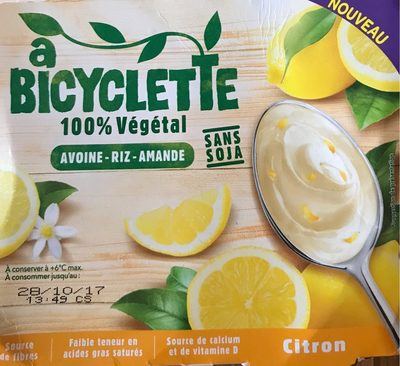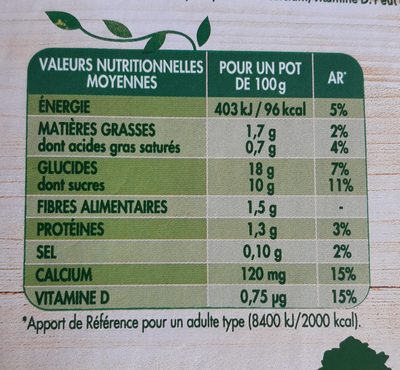A Bicyclette Citron - 400 g
This product page is not complete. You can help to complete it by editing it and adding more data from the photos we have, or by taking more photos using the app for Android or iPhone/iPad. Thank you!
×
Barcode: 3523230040259 (EAN / EAN-13)
Quantity: 400 g
Packaging: Plastic, Pot, Cardboard, Fresh
Brands: A Bicyclette
Categories: Plant-based foods and beverages, Dairy substitutes, Desserts, Non-dairy desserts
Labels, certifications, awards:
Vegetarian, Vegan, European Vegetarian Union, European Vegetarian Union Vegan, No lactose

Origin of ingredients: fr:Europe du Nord
Manufacturing or processing places: France
Link to the product page on the official site of the producer: http://www.a-bicyclette-vegetal.fr
Stores: Magasins U
Countries where sold: France
Matching with your preferences
Environment
Packaging
Transportation
Report a problem
Data sources
Product added on by kiliweb
Last edit of product page on by worldtest.
Product page also edited by autorotate-bot, bobobeauvais, francois-mace, magasins-u, moon-rabbit, nadine56, openfoodfacts-contributors, packbot, quechoisir, sebleouf, yuka.R3Y5Wks3OEhwNmNMdXNNSDBSZlQrdFI0NTVPUlhqbWxOZk00SUE9PQ, yuka.VC93Zk5vaGZqZkF6cXNRQzdDTHErZXB0OXBHT2NINnBLYkFVSWc9PQ, yuka.VGFVNU41Z2d2dVlvbzhNajlSM3U4TjBxMjYycVhqTHJEdkFxSVE9PQ, yuka.WjRjTU80MG9ndDBKeTlnR3hERHYxNGtwd0thc1p6NlZLdXdBSWc9PQ, yuka.ZnBzT0FyNVl1T2d4d1BBUTJ4cisrY2xMNjVTeVhscU5Lc3NCSVE9PQ.










